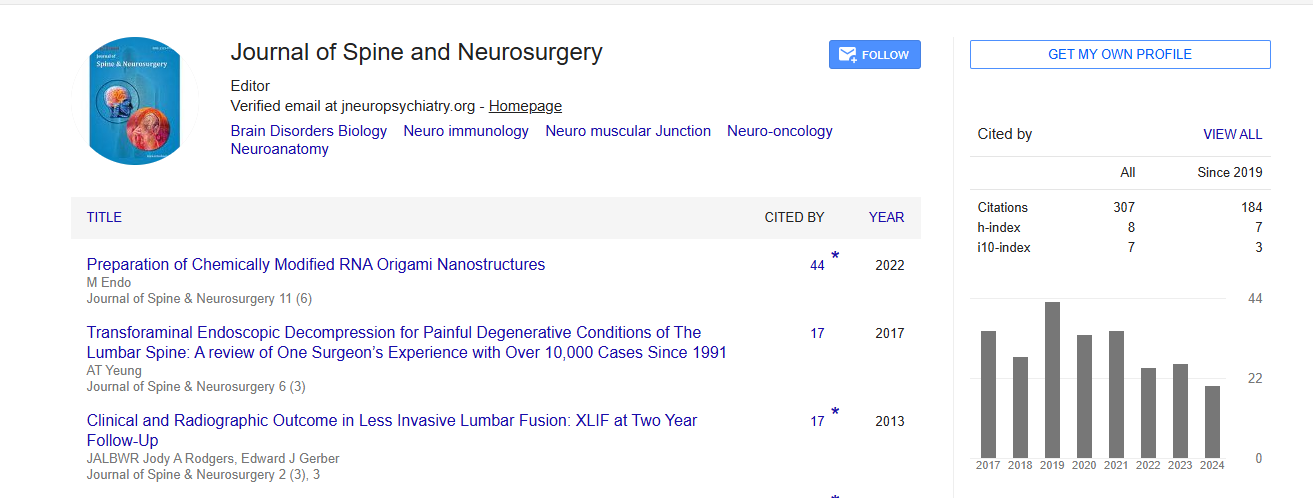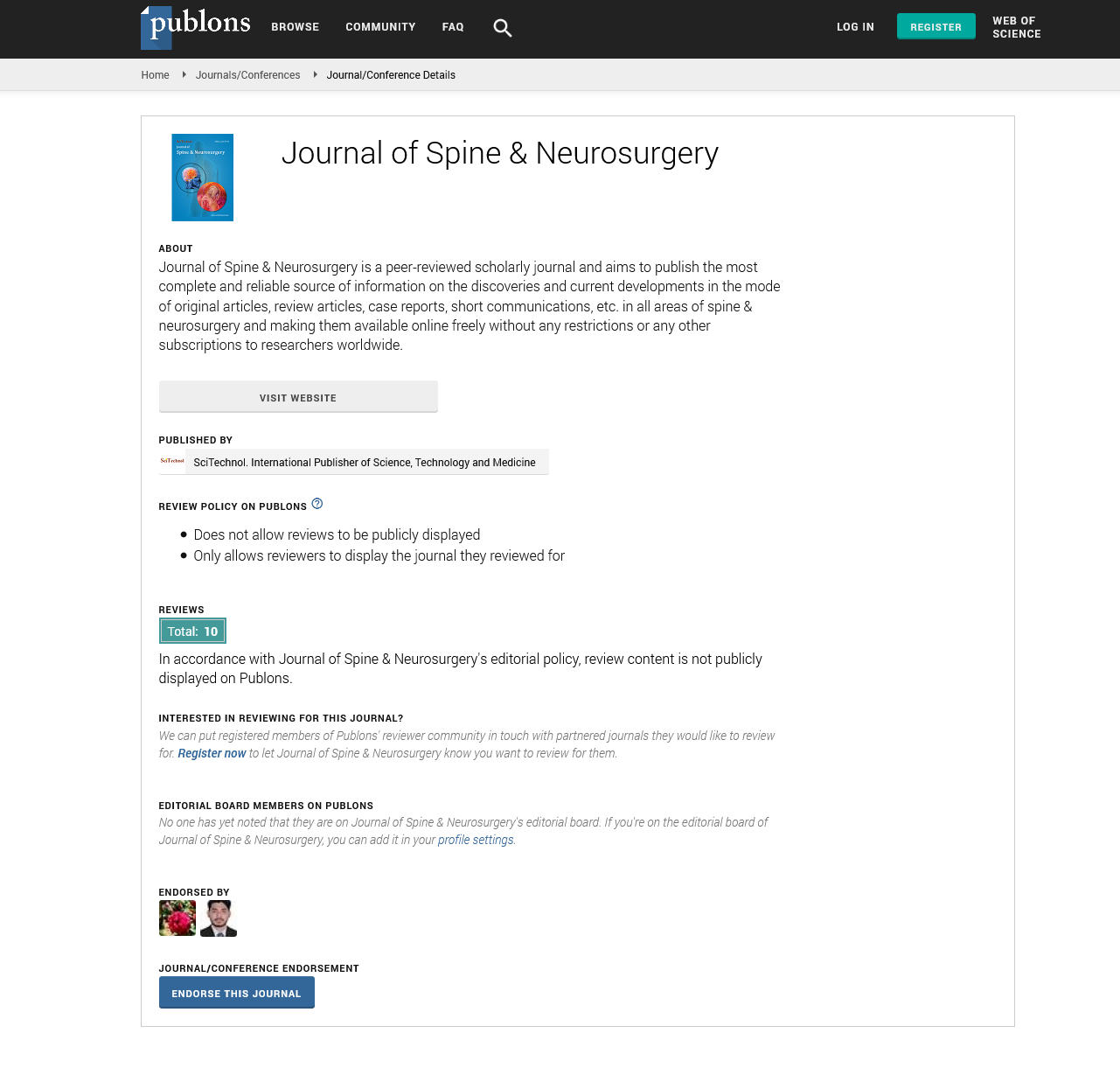Commentary, J Spine Neurosurg Vol: 13 Issue: 4
The Science of Spinal Motion: How Biomechanics Dictates Spine Health
Dan Pei*
1Department of Neurological Surgery, The University of Miami, Miami, USA
*Corresponding Author: Dan Pei,
Department of Environmental Sciences Division,
Oak Ridge National Laboratory, Oak Ridge, USA
E-mail: dampei784j@ornl.gov
Received date: 27 July, 2024, Manuscript No. JSNS-24-152423;
Editor assigned date: 30 July, 2024, PreQC No. JSNS-24-152423 (PQ);
Reviewed date: 12 August, 2024, QC No. JSNS-24-152423;
Revised date: 19 August, 2024, Manuscript No. JSNS-24-152423 (R);
Published date: 29 August, 2024, DOI: 10.4172/2325-9701.1000212.
Citation: Pei D (2024) The Science of Spinal Motion: How Biomechanics Dictates Spine Health. J Spine Neurosurg 13:2.
Description
The human spine is an engineering marvel, intricately designed to support the body, protect the spinal cord and enable movement. Spinal biomechanics, the study of the mechanical principles governing spine function, is a critical area of research in both clinical and engineering fields. Understanding the forces at work on the spine can enhance surgical outcomes, improve treatment strategies for spinal disorders, and lead to innovations in spinal implants and devices. This article explores the fundamental aspects of spinal biomechanics, its relevance to clinical practice and the implications for patient care.
The spine consists of 33 vertebrae organized into five distinct regions: cervical (neck), thoracic (mid-back), lumbar (lower back), sacral and coccygeal (tailbone). Each vertebra is separated by intervertebral discs, which function as shock absorbers, cushioning the vertebrae and facilitating motion between them. These discs are made of a gelatinous nucleus pulposus surrounded by a fibrous annulus fibrosus. The intervertebral discs, combined with facet joints and ligaments, allow the spine to bend, twist and rotate while maintaining structural integrity.
The biomechanical forces exerted on the spine include compression, tension, shear and torsion. These forces are generated through movements such as flexion, extension, lateral bending and axial rotation, as well as during everyday activities like walking, lifting and sitting. The ability of the spine to withstand and manage these forces is important for maintaining both function and stability. The natural curvature of the spine plays an important role in its biomechanics. The cervical and lumbar regions are lordotic, while the thoracic and sacral regions are kyphotic (curving outward). These curves allow for optimal load distribution across the vertebral column and play a role in shock absorption during physical activities. The curvature also enables the spine to adapt to dynamic postures, such as bending forward or twisting the torso, without causing excessive strain on the surrounding muscles and ligaments.
Disruptions in spinal curvature, such as in cases of scoliosis (abnormal lateral curvature) or hyperkyphosis (excessive outward curvature), can lead to biomechanical dysfunctions, contributing to pain, weakness and reduced mobility. Such deformities can place abnormal loads on certain areas of the spine, leading to disc degeneration, facet joint arthritis and even nerve impingement over time.
Spinal loading refers to the distribution of forces through the spine, which occurs during activities such as standing, walking, or lifting. When these forces exceed the spine's structural capacity, injury or damage can occur. Understanding how the spine handles loads is fundamental in developing treatment strategies for spinal disorders.
The spine is primarily loaded in the axial direction, meaning that weight is transmitted vertically from the head through the vertebrae and into the pelvis. This load is borne by the vertebral bodies and the intervertebral discs, which help distribute the pressure evenly. Lateral forces, such as those experienced during twisting motions, create shear forces that can strain the spinal structures, including ligaments and discs. Prolonged exposure to shear forces can accelerate the degeneration of spinal tissues. The spine's ability to bend or flex is governed by the interaction of muscles, ligaments and the discs between the vertebrae. For instance, when bending forward the anterior structures of the spine are compressed, while the posterior (back) structures are stretched.
Many spinal disorders can be understood in terms of biomechanical disruptions. For instance, herniated discs occur when the nucleus pulposus of an intervertebral disc pushes through the annulus fibrosus, often as a result of excessive loading or a traumatic event. This herniation can compress adjacent nerve roots, leading to pain, weakness, or numbness in the limbs.
Degenerative changes in the spine, such as spondylosis degeneration of the intervertebral discs and joints, can also be attributed to altered biomechanics. Repetitive stress and abnormal loading patterns, often due to poor posture, incorrect lifting techniques, or age-related changes, lead to degeneration of spinal tissues, loss of disc height and the formation of osteophytes (bone spurs). Spinal deformities like scoliosis or kyphosis can cause maladaptive changes in spinal biomechanics. In scoliosis, for instance, the abnormal lateral curvature alters the distribution of weight and pressure across the spine, increasing the risk of disc degeneration, joint pain and muscle fatigue.
Conclusion
Recent advancements in spinal biomechanics have led to significant innovations in the treatment of spinal disorders. For example, Minimally Invasive Spine Surgery (MISS) techniques have been trauma developed to reduce trauma to the surrounding tissues while addressing spinal deformities or disc herniations. These techniques rely on a better understanding of biomechanical principles to restore spinal stability with minimal disruption. In addition, the development of biomechanically optimized spinal implants, such as artificial discs and pedicle screws, has revolutionized spinal surgery. These devices are designed to restore normal motion and load distribution in the spine after conditions like disc herniation or vertebral fractures. Advanced Computer-Aided Design (CAD) and finite element modeling techniques allow for customized implants that match the unique anatomical and biomechanical characteristics of each patient. As technology advances, so too does our ability to analyze and intervene in spinal biomechanics, improving both the quality of life and outcomes for individuals suffering from spine-related issues.
 Spanish
Spanish  Chinese
Chinese  Russian
Russian  German
German  French
French  Japanese
Japanese  Portuguese
Portuguese  Hindi
Hindi 
